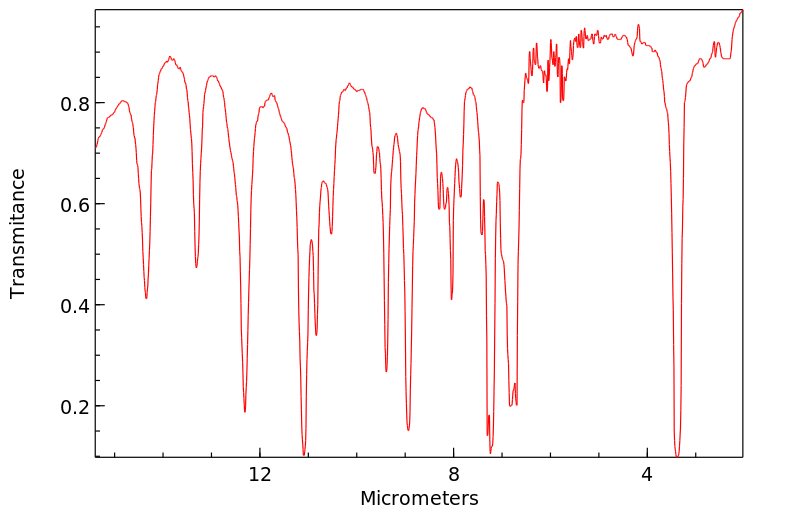2,3-环氧-2,4,4-三甲基戊烷 | 96-06-0
中文名称
2,3-环氧-2,4,4-三甲基戊烷
中文别名
——
英文名称
2,3-epoxy-2,4,4-trimethylpentane
英文别名
3-tert-butyl-2,2-dimethyloxirane;2,3-Epoxy-2,4,4-trimethylpentan;2,4,4-Trimethylpent-2-ene oxide;β-Diisobutenoxid;3-tert-butyl-2,2-dimethyl-oxirane;Oxirane, 3-(1,1-dimethylethyl)-2,2-dimethyl-
CAS
96-06-0
化学式
C8H16O
mdl
——
分子量
128.214
InChiKey
OUYYZNFRPHQCIM-UHFFFAOYSA-N
BEILSTEIN
——
EINECS
——
-
物化性质
-
计算性质
-
ADMET
-
安全信息
-
SDS
-
制备方法与用途
-
上下游信息
-
文献信息
-
表征谱图
-
同类化合物
-
相关功能分类
-
相关结构分类
计算性质
-
辛醇/水分配系数(LogP):2.3
-
重原子数:9
-
可旋转键数:1
-
环数:1.0
-
sp3杂化的碳原子比例:1.0
-
拓扑面积:12.5
-
氢给体数:0
-
氢受体数:1
安全信息
-
海关编码:2910900090
SDS
上下游信息
-
下游产品
中文名称 英文名称 CAS号 化学式 分子量 2,4,4-三甲基戊烷-2,3-二醇 2,3-Dihydroxy-2,4,4-trimethylpentan 64512-96-5 C8H18O2 146.23
反应信息
-
作为反应物:描述:参考文献:名称:Byers; Hickinbottom, Journal of the Chemical Society, 1948, p. 286摘要:DOI:
-
作为产物:描述:2,4,4-三甲基-2-戊烯 在 silica-supported cobalt acetate 氧气 、 异丁醛 作用下, 以 二氯甲烷 为溶剂, 反应 5.0h, 以95%的产率得到2,3-环氧-2,4,4-三甲基戊烷参考文献:名称:Environmentally friendly catalysis using supported reagents: catalytic epoxidation using a chemically modified silica gel摘要:基于化学改性的介孔硅胶和固定化钴离子的全新非均相催化剂被开发出来,并成功应用于烯烃的环氧化反应。DOI:10.1039/cc9960001859
文献信息
-
Aldehyde/olefin cooxidations: Parallel epoxidation pathways and concerted decomposition of the peroxyacyl-olefin adduct作者:Kevin R. Lassila、Francis J. Waller、Steven E. Werkheiser、Amy L. WressellDOI:10.1016/0040-4039(94)88247-9日期:1994.10Aldehyde-mediated olefin epoxidations appear to proceed by parallel peracid and radical addition pathways. For that portion of the reaction proceeding by radical addition, several lines of evidence favor an explanation in which the peroxyacyl-olefin adduct decomposes in a concerted manner to form alkyl radical, CO2, and epoxide.醛介导的烯烃环氧化似乎是通过平行的过酸和自由基加成途径进行的。对于通过自由基加成进行的那部分反应,有几条证据支持一种解释,其中过氧酰基-烯烃加合物以一致的方式分解形成烷基,CO 2和环氧化物。
-
A novel hexanuclear heteropolyperoxo oxidation catalyst: preparation, X-ray crystal structure and reactions of [NMe<sub>4</sub>]<sub>3</sub>[(MePO<sub>3</sub>){MePO<sub>2</sub>(OH)}W<sub>6</sub>O<sub>13</sub>(O<sub>2</sub>)<sub>4</sub>(OH)<sub>2</sub>(OH<sub>2</sub>)]·4H<sub>2</sub>O作者:William P. Griffith、Bernardeta C. Parkin、Andrew J. P. White、David J. WilliamsDOI:10.1039/c39950002183日期:——The crystal structure of the title compound, 1, reveals the presence of two distinct types of tungsten atom in which the four bearing peroxo groups have distorted pentagonal-bipyramidal geometries and the remaining two are octahedral; 1 is an effective catalyst for monoalkene epoxidation, and the oxidation of primary and secondary alcohols, with H2O2 as co-oxidant.
-
Epoxidation of alkenes using alkyl hydroperoxides generated in situ by catalytic autoxidation of hydrocarbons with dioxygen作者:Takahiro Iwahama、Gou Hatta、Satoshi Sakaguchi、Yasutaka IshiiDOI:10.1039/a908731a日期:——Olefins were smoothly epoxidized under O2 (1 atm) in the presence of a hydrocarbon such as ethylbenzene or tetralin, using N-hydroxyphthalimide (NHPI) and Mo(CO)6 as catalyst; the present reaction involves autoxidation of the hydrocarbon assisted by NHPI and epoxidation of alkenes with the resulting hydroperoxide catalyzed by Mo(CO)6; cis-alkene was epoxidized in a stereospecific manner to form the
-
Covalent Heterogenization of a Discrete Mn(II) Bis-Phen Complex by a Metal-Template/Metal-Exchange Method: An Epoxidation Catalyst with Enhanced Reactivity作者:Tracy J. Terry、T. Daniel P. StackDOI:10.1021/ja0742030日期:2008.4.1along with the epoxidation reactivity once reloaded with manganese. Comparisons of this imprinted material with material synthesized by random grafting of the ligand show that the template method creates more reproducible, solution-like bis-1,10-phenanthroline coordination at a variety of ligand loadings. Olefin epoxidation with peracetic acid shows the imprinted manganese catalysts have improved product由于位点隔离可能带来的好处,例如增加催化剂稳定性、催化剂回收和产品分离,将分散的环氧化催化剂固定在固体载体上引起了相当大的关注。本文报道了一种合成金属模板/金属交换方法,可将共价连接的双-1,10-菲咯啉配位环境印记到高表面积介孔 SBA-15 二氧化硅上,并在重新加载锰后具有环氧化反应性。这种印迹材料与通过配体随机接枝合成的材料的比较表明,模板方法在各种配体负载下产生了更具重现性的、类似溶液的双 1,10-菲咯啉配位。烯烃与过乙酸的环氧化表明,印迹锰催化剂对环氧化物的产物选择性有所提高,底物范围更大,氧化剂的使用更有效,并且比其均相或接枝类似物具有更高的反应性,而不受配体负载的影响。然而,随机接枝的锰催化剂显示出随着配体负载而变化的反应性,而均相类似物降解三取代的烯烃并从顺式烯烃产生反式环氧化物产物。模板化催化剂的有效回收行为也是可能的。显示反应性随配体负载而变化,而均相类似物降解三取代
-
Manganese(II)/Picolinic Acid Catalyst System for Epoxidation of Olefins作者:Ross A. Moretti、J. Du Bois、T. Daniel P. StackDOI:10.1021/acs.orglett.6b00518日期:2016.6.3An in situ generated catalyst system based on Mn(CF3SO3)2, picolinic acid, and peracetic acid converts an extensive scope of olefins to their epoxides at 0 °C in <5 min, with remarkable oxidant efficiency and no evidence of radical behavior. Competition experiments indicate an electrophilic active oxidant, proposed to be a high-valent Mn = O species. Ligand exploration suggests a general ligand sphere
表征谱图
-
氢谱1HNMR
-
质谱MS
-
碳谱13CNMR
-
红外IR
-
拉曼Raman
-
峰位数据
-
峰位匹配
-
表征信息
同类化合物
(S)-4-氯-1,2-环氧丁烷
顺式-环氧琥珀酸氢钾
顺式-1-环己基-2-乙烯基环氧乙烷
顺-(2S,3S)甲基环氧肉桂酸酯
雌舞毒蛾引诱剂
阿洛司他丁
辛基缩水甘油醚
试剂(3S,6S)-(-)-3,6-Diisopropyl-1,4-dioxane-2,5-dione
表氰醇
螺[环氧乙烷-2,2-三环[3.3.1.1~3,7~]癸烷]
蛇根混合碱
benzene oxide
聚碳酸丙烯酯
聚依他丁
羟基乙醛
缩水甘油基异丁基醚
缩水甘油基十六烷基醚
缩水甘油
硬脂基醇聚氧乙烯聚氧丙烯醚
硅烷,三甲基[(3-甲基噁丙环基)乙炔基]-,顺-
盐酸司维拉姆
甲醛与(氯甲基)环氧乙烷,4,4-(1-甲基乙亚基)双酚和2-甲基苯酚的聚合物
甲醛与(氯甲基)环氧乙烷,4,4'-(1-甲基乙亚基)二[苯酚]和4-(1,1,3,3-四甲基丁基)苯酚的聚合物
甲醇环氧乙烷与壬基酚的聚合物
甲胺聚合物与(氯甲基)环氧乙烷
甲硫代环氧丙烷
甲基环氧氯丙烷
甲基环氧巴豆酸酯
甲基环氧乙烷与环氧乙烷和十六烷基或十八烷基醚的聚合物
甲基环氧乙烷与[(2-丙烯基氧基)甲基]环氧乙烷聚合物
甲基环氧丙醇
甲基环氧丙烷
甲基N-丁-3-烯酰甘氨酸酸酯
甲基7-氧杂双环[4.1.0]庚-2,4-二烯-1-羧酸酯
甲基3-环丙基-2-环氧乙烷羧酸酯
甲基1-氧杂螺[2.5]辛烷-2-羧酸酯
甲基(2S,3R)-3-丙基-2-环氧乙烷羧酸酯
甲基(2R,3S)-3-丙基-2-环氧乙烷羧酸酯
甲基(2R,3R)-3-环丙基-2-环氧乙烷羧酸酯
环氧溴丙烷
环氧氯丙烷与双酚A、4-(1,1-二甲乙基)苯酚的聚合物
环氧氯丙烷-d5
环氧氯丙烷-D1
环氧氯丙烷-3,3’-亚氨基二丙胺的聚合物
环氧氯丙烷-2-13C
环氧氯丙烷
环氧氟丙烷
环氧树脂(环氧氯丙烷和二乙二醇)
环氧树脂
环氧柏木烷







